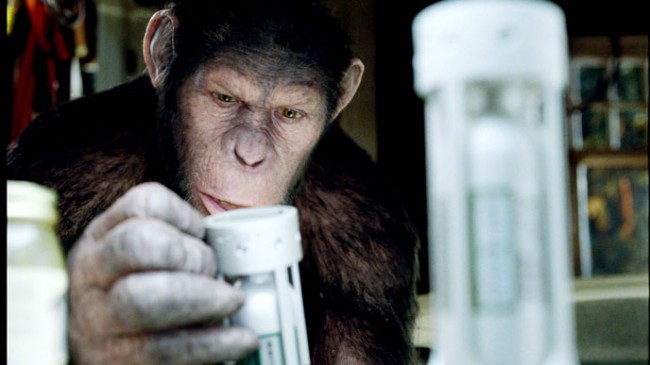Rise of the Planet of the Apes
Scarier than Dunston Checks In

Starring: James Franco, CGI
Review written by Robert Patrick
You get the impression that “Rise of the Planet of the Apes” is less a movie and more of a trailer, especially considering, when all is said and done, that the film sets the table for an innumerable amount of sequels and prequels. Not much happens in “Rise,” until the very end of the picture, and we’re left to wait for the next installment of the series for the bulk of the action. In the meantime, though, we’re left to watch James Franco do his best interpretation of “Monkey Shines.” Not all of the film is bad, however, and to say that “Rise of the Planet of the Apes” doesn’t benefit from its technical prowess – nobody is going to say that the ninety-million dollars that went into this movie was spent on Craft services – is a lie, but the insipid pacing of the film makes me feel like I could’ve solved Fermat’s Last Theorem, balanced my checkbook, and simultaneously learned Latin before any action transpired in the film. The original “Apes” films were cheesy, bombastic, overbaked hokum. Watching Roddy McDowell with some rubber prosthetics lumped to his dome was pretty entertaining, but here, in this revisionist, squeaky clean computer animated world of vaccines-gone-wrong, the plasticity of the literal monkey suits used in the original “Apes” canon is replaced with slick, fluid, astonishingly crisp CGI interpretations – and while this is pretty outstanding, the hybrid of fun and terror has been siphoned from the film. The computer animations are visceral and convincing, but sometimes, when the special effect teams get carried away, the motion capture looks of athetosis.
Being that I’ve never been a fan of CGI (give me staccato animatronic wolves any day of the week over the pixilated, magnetic board playsets of today’s computer technology) I have been hard to a lot of movies, but “Rise of the Planet of the Apes” is the most marvelous, seamless, tangible looking use of computer generated graphics that I have ever seen. These apes interact with their world as if they live in it. And though I mentioned that the film is more breathy, cold and clinical than its predecessors, it’s also, technically, a wondrous achievement. The sound mixing of “The Rise of the Planet of the Apes” is a phenomenal wingman to the movie’s mostly extraordinary CGI, as primordial growls permeate the theater and cause, one could assume, mini-anxiety attacks for the frailest of movie patrons. Sometimes the effects can go on for too long, for no apparent reason other than to exercise its muscle, but the lack of brevity is welcome after we’re shown innocuous romantic sub plots with James Franco – who, by the way, is about as emotive as a death mask in this film.
I have strayed from the synopsis, as you have probably noticed, as I ponder to myself if it’s really all that necessary to describe the plot in great detail – the story is pretty antiquated for those familiar with the “Apes” series, and even with small alterations from the original back story, it’s pretty basic stuff: James Franco is a scientist with good intentions; good intentions turn into poor reactions; poor reactions turn into revolting apes; revolting apes turn into many, many, many sequels. This isn’t the worst origin story to hit cinemas in the past few years, but it’s certainly not the best, either. One can suspect a logjam for moviegoers to get into the theater, but, as much I don’t think it’s a good film, there is no arguing that the artisan craftsmanship of the special effects merits the price of admission. In addition, John Lithgow portrays what looks like a dementia stricken Randy Newman, complete with huge glasses, a receding hairline, and a liking for the piano. Taper your expectations – a lot – and enjoy when the effects are used appropriately. And, while you’re at it, please remove the aberration that is Tim Burton’s “Planet of the Apes” from your poor gulliver.
